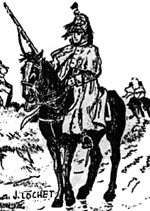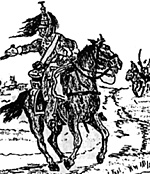During our lecture "From the Permanent Divisions of the Seven Years War to the Napoleonic Army Corps" at Historicon 95, in which we discussed the role of the light cavalry during the advance of the battalion carré, we were asked to explain how light cavalry could screen an army, perform picket duties, perform reconnaissance and the like. Were there specific procedures?
In our opinion, the question is much broader than that outlined above. First, we have to define what light cavalry was and how it differed from heavy cavalry (sometimes called "battle cavalry") which, basically, was trained to smash enemy formation with the charge. The light cavalry played a significantly different role. Its principal missions included outpost duties, skirmishing, reconnaissance and the pursuit of defeated enemies, which does not mean that light cavalry was not employed as "battle cavalry". Battle reports confirm their usage as such. To be complete, we should also mention that the dragoons, especially in French service, were often called on to perform the functions of the light cavalry in addition to their traditional duties. 1
In French service, as in most other armies, the light cavalry was mounted on smaller horses than those of the heavy cavalry and the dragoons 2. In all the continental armies, it was generally accepted that smaller horses were better suited for the primary missions of the light cavalry. However, the size of its horses had little to do with the mission of the light cavalry. What was considerably more important was its basic training.
When light cavalry operated as an advance guard, rear guard, on the wings screening the army, or performing reconnaissance, it was almost always broken down into detachments smaller than the regiment, the squadron or even the company. We shall cover first what we may call static screening by the light cavalry.
In French service, when light cavalry (and sometimes dragoons) was assigned to vanguard duties, it first established a grand'garde several hundred yards from the troops it had to protect. Then, the grand'garde dispatched several petits postes, which in turn placed ahead several vedettes in chosen locations. Usually, a single (sometime two) vedette was posted on a critical spot and was relieved every hour. The vedette was not allowed to dismount under any circumstances and always had to keep his musket or pistol in a "high" firing position. In addition, he had strict orders to fire if under attack to alert the rest of the picket or petit poste.
That system, when properly applied, provided a close net of vedettes, which prevented troops from being surprised by the enemy. The strength of the cavalry to be engaged in such duties depended on the frontage to be covered, but consisted of at least one squadron, which of course was subdivided as described above.
Patrols
The static screening system was very often complemented by sending patrols out ahead of the vedettes to determine the enemy's whereabouts and intentions. These patrols were most often small detachments of consisting of two troopers and a brigadier (a NCO rank equivalent to corporal in other armies). Like the vedettes, the patrols had strict orders not to fire unless engaged by the enemy, to defend themselves and warn their companions to the rear.
Screening
The role of the light cavalry screen during an advance was not very different from its static function. A detachment of light cavalry always marched ahead of a brigade, Division or army corps and beside reconnoitering ahead, protected the flanks. That was done by sending out numerous cavalry patrols (vedettes volantes, i.e. "flying vedettes") ahead and on parallel routes to the main advance (in addition to the standard cavalry screen of vedettes similar to the static defense). Most of the time, this system was also sufficient to deny to the enemy cavalry any information on the whereabouts and movements of the army corps, Division or brigade. Of course, these patrols were kept in contact with the main vanguard and its vedettes.
Reconnaissance
Like every other commander, Napoleon used spies to some extent to discover as much as possible the enemy's movements and dispositions, but spies were of limited value. Therefore, cavalry reconnaissance was clearly essential and provided the bulk of the intelligence along with the Corps advance guards. Hence, during the advance of the Bataillon Carré, the light cavalry, beside screening the Grande Armée, had to seek out and provide the required intelligence to Imperial Headquarters. It was done by sending out reconnaissance parties, sometimes deep into enemy territory. The effective strength of such reconnaissance parties varied from a few men to much larger parties in prportion to the scope of the mission. 3
But it was not always possible to swallow a message if captured and De Brack 5 recommended the following procedure be used to avoid a message from being captured: "... a sure place to guarantee the safety of a report is the barrel of a pistol: there, made in a ball with some additional paper if necessary, it can be used instead of wadding, and if the messenger sees that he can not escape capture, in firing his pistol at the last moment, he destroys it." 6
Conclusions
In the early Empire (1805 through 1809), the screening and reconnaissance system used by the numerous well-trained French light cavalry was unique and extremely efficient. Because of its organization and its very flexible system of attributing light cavalry to army corps 7 , the light cavalry provided Napoleon with the basic information he needed to force the enemy to a decisive battle 8 . His opponents were usually unable to field enough light cavalry to achieve the same degree of reconnaissance to discover enemy whereabouts and intentions. 9 During the early years of the Empire, the Allies operated most of the time in complete darkness. In the 1805 Ulm campaign, the unfortunate Austrian commander Mack, because of the lack of adequate light cavalry reconnaissance, had no idea of the strategic storm that was about to hit him until it was too late. The same happened to the Prussians during the Campaign of 1806.
Elsewhere in the present issue see Mike Gilbert's article On Cavalry Vedettes, and A Long Range Reconnaissance.
Aubier, Lt. Colonel A. La cavalerie napoléonienne peut-elle encore servir de modèle?, Berger-Levrault, Paris, 1902. Footnotes:
1 To be covered in a future article. This article appears in MagWeb (Magazine Web) on the Internet World Wide Web. At right, a dragoon circa 1815, wearing a long white coat on vedette duty. Other dragoons in the rear are ready to assist. Dragoons were capable of light cavalry duties. Drawing made from Commandant Bucquoy, "Les Uniformes du Premier Empire, Dragoons et Guides," Paris 1980.
At right, a dragoon circa 1815, wearing a long white coat on vedette duty. Other dragoons in the rear are ready to assist. Dragoons were capable of light cavalry duties. Drawing made from Commandant Bucquoy, "Les Uniformes du Premier Empire, Dragoons et Guides," Paris 1980.
Static Screening by Light Cavalry
Dynamic Light Cavalry Missions
 A Dragoon in vedette duties, retreating towards the petit poste, firing his pistol to protect himself and alert the petit poste, which is coming to assist the vedette. Drawing made from Commandant Bucquoy, "Les Uniformes du Premier Empire, Dragoons et Guides," Paris 1980.
Beside locating the enemy and evaluating his forces, the additional purposes of reconnaissance were to reconnoiter the terrain and if possible, take prisoners to extract information from them. To be efficient, the result of reconnaissance had to be forwarded to Headquarters, which could be that of a brigade, Division, army corps and, whenever necessary, Imperial Headquarters. These reports were transmitted by intelligent and well-mounted horsemen. The report was usually placed inside the gloves of the messenger, who had orders to swallow the message if captured by the enemy. 4
A Dragoon in vedette duties, retreating towards the petit poste, firing his pistol to protect himself and alert the petit poste, which is coming to assist the vedette. Drawing made from Commandant Bucquoy, "Les Uniformes du Premier Empire, Dragoons et Guides," Paris 1980.
Beside locating the enemy and evaluating his forces, the additional purposes of reconnaissance were to reconnoiter the terrain and if possible, take prisoners to extract information from them. To be efficient, the result of reconnaissance had to be forwarded to Headquarters, which could be that of a brigade, Division, army corps and, whenever necessary, Imperial Headquarters. These reports were transmitted by intelligent and well-mounted horsemen. The report was usually placed inside the gloves of the messenger, who had orders to swallow the message if captured by the enemy. 4
Sources:
Bonie, General T. La cavalerie au combat, Baudoin & Cie, Paris 1887.
Bismark, comte von Bismark Tactique de la cavalerie, Levrault, Paris 1821.
De Brack, Avant postes de cavalerie légère, Paris, date unknown.
Chandler, David The Campaigns of Napoleon, Macmillan, N.Y. 1966.
Parquin, Charles Napoleon's Army, London 1969.
de Lee, Nigel French Lancers, Almark Publishing Co. London 1967.
Misc. notes and documents from French archives (Archives Guerre).
2 It is interesting to note that in French service the dragoons were classified as light cavalry, both in the Royal Army and that of the Revolution.
3 That statement holds true for the continental armies with the notable exception of British cavalry. See EE&L 5 On Cuirassiers, Dragoons and Medium Cavalry, pp. 28 to 32, where it is clearly shown that there was little difference between the size of British heavy cavalry horses and those of British light cavalry.
4 Bonie, La cavalerie au combat
5 De Brack, Avant postes de cavalerie légère
6 That was an ingenious trick but many important messages and dispatches were captured by the enemy.
7 A fixed contingent of light cavalry was assigned to each army corps, but only as a function of the mission to be performed.
8 The organization of the Napoleonic corps system and the strategic usage of the Bataillon Carré will be covered at length in EE&L Vol 3 No 2 under the title "On the Evolution of French Army Organization from Permanent Divisions to Army Corps, Part III: The Army Corps of the Empire".
9 See Part II of "On the Evolution of French Army Organization from Permanent Divisions to Army Corps, Part II: The Divisional System in the Armies of the Revolution." in which it is shown that cavalry in the French Revolutionary armies, as well as in the Allied armies, were an integral part of the permanent Divisions in the French army and of the "ad hoc" formation in the Allied armies.
Back to Empire, Eagles, & Lions Table of Contents Vol. 3 No. 1
© Copyright 1996 by Jean Lochet
Other military history articles and gaming articles are available at http://www.magweb.com
